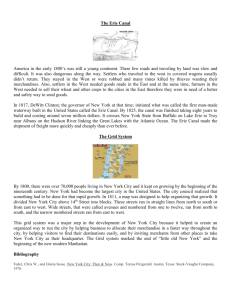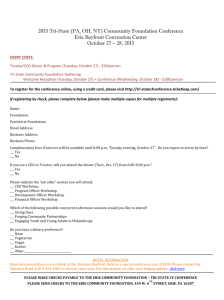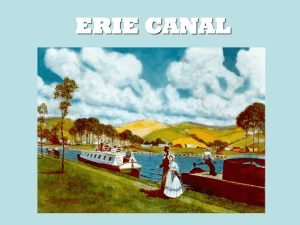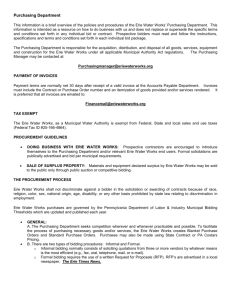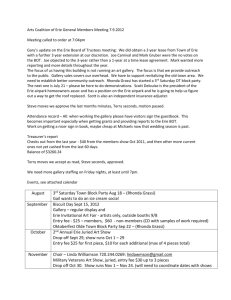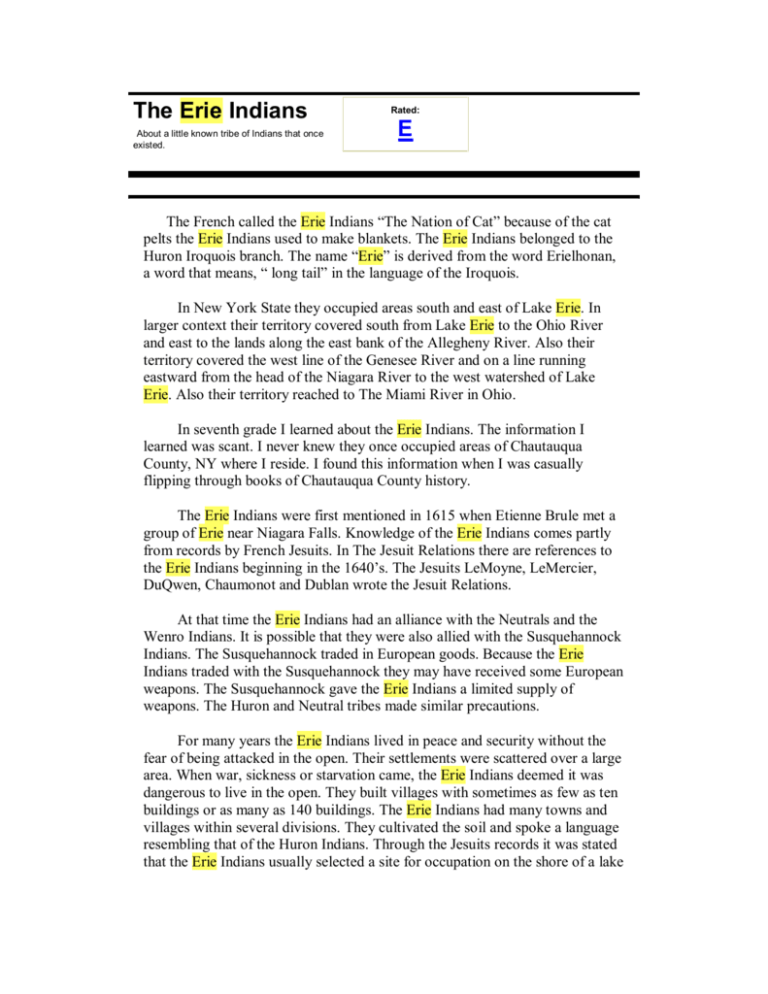
The Erie Indians
About a little known tribe of Indians that once
existed.
Rated:
E
The French called the Erie Indians “The Nation of Cat” because of the cat
pelts the Erie Indians used to make blankets. The Erie Indians belonged to the
Huron Iroquois branch. The name “Erie” is derived from the word Erielhonan,
a word that means, “ long tail” in the language of the Iroquois.
In New York State they occupied areas south and east of Lake Erie. In
larger context their territory covered south from Lake Erie to the Ohio River
and east to the lands along the east bank of the Allegheny River. Also their
territory covered the west line of the Genesee River and on a line running
eastward from the head of the Niagara River to the west watershed of Lake
Erie. Also their territory reached to The Miami River in Ohio.
In seventh grade I learned about the Erie Indians. The information I
learned was scant. I never knew they once occupied areas of Chautauqua
County, NY where I reside. I found this information when I was casually
flipping through books of Chautauqua County history.
The Erie Indians were first mentioned in 1615 when Etienne Brule met a
group of Erie near Niagara Falls. Knowledge of the Erie Indians comes partly
from records by French Jesuits. In The Jesuit Relations there are references to
the Erie Indians beginning in the 1640’s. The Jesuits LeMoyne, LeMercier,
DuQwen, Chaumonot and Dublan wrote the Jesuit Relations.
At that time the Erie Indians had an alliance with the Neutrals and the
Wenro Indians. It is possible that they were also allied with the Susquehannock
Indians. The Susquehannock traded in European goods. Because the Erie
Indians traded with the Susquehannock they may have received some European
weapons. The Susquehannock gave the Erie Indians a limited supply of
weapons. The Huron and Neutral tribes made similar precautions.
For many years the Erie Indians lived in peace and security without the
fear of being attacked in the open. Their settlements were scattered over a large
area. When war, sickness or starvation came, the Erie Indians deemed it was
dangerous to live in the open. They built villages with sometimes as few as ten
buildings or as many as 140 buildings. The Erie Indians had many towns and
villages within several divisions. They cultivated the soil and spoke a language
resembling that of the Huron Indians. Through the Jesuits records it was stated
that the Erie Indians usually selected a site for occupation on the shore of a lake
or point of land between a stream and its branch.
The women made earthen pots for cooking and wove rush mats. They
also spun twine from hemp of which they made mats by rolling them on their
thighs. They pounded corn with stone pestles in wooden mortars. The Erie
Indians used stone axes, spears, arrowheads and bones for fishhooks.
The main crops were corn, beans and squash. Following a harvest the
Erie Indians would embark on a winter hunt. They made clothes from the skins
of animal such as deer and beaver. The skins were converted into leather. Some
of the skins had the hair left on them so the hairy side could be worn next to the
body in winter for warmth. In warm weather they would wear skins with the
hair outward. Sometimes they would make coats out of the feathers of turkeys.
They made shoes of deerskins.
Sometimes the Erie Indians built palisades of three concentric rows lined
inside with bark above bark. They would construct standing places on these
palisades for defenders. They had gutters to carry water to put out fires started
by assailants.
The palisades or stockades of the Erie Indians were made of wooden
stakes from tree trunks that were between fifteen to thirty feet high. Each stake
was placed very close to the next one and each was sharpened to a fine point.
Sometimes they built the stockades extra thick. They would build three rows of
stakes and planted the middle row straight up and down. They crossed and
interlaced the other stakes.
Fire was the only way to destroy an Erie stockade. Sometimes fire would
not succeed because each stockade was equipped with firefighting equipment.
Inside a stockade wall about five feet from the ground was a top platform
lashed to upright supports with rope made from inner fibers of a basswood tree.
On this platform they kept clay or leather pots of water to put out the fires of
burning arrows. They also kept a supply of stones on the platform to throw at
assailants.
The Erie Indians dug a trench about four or six feet deep all around a
village. The earth was removed and piled next to the village to make a wall of
earth ten to twelve feet high. On top of this wall they placed a thick layer of
brambles and briers. The noted warriors of the Erie Indians fought with
poisoned arrows.
The Erie Indians built funeral mounds. Records of the Erie Indians’
funeral practices come mainly from Brabeaf a Jesuit who resided for years
among the Erie Indians. According to Brabeaf when an Erie Indian died the
body was first placed on a scaffold. The tribe would hold a crying ceremony.
They also sang and danced around a fire. This ceremony lasted five days.
When the ceremony started, five knots were tied in a piece of milkweed. Each
day of the ceremony they would untie one knot. A great funeral ceremony was
held at intervals of every ten to twelve years. The remaining flesh was removed
from corpses and the bones of other dead were gathered. All the Erie Indians
usually participated in this ceremony. The corpses and bones were arranged in
order of the largest houses of different villages.
Amid weeping and howling, bones and corpses were born upon litters on
the shoulders of the Indians. A great concourse was assembled from different
villages at the principal town to participate in funeral games. Houses were
filled to overflowing and some gathered around campfires in the woods.
Funeral gifts, bones and corpses were suspended from cross poles over graves.
A deceased person was first interred in a single grave. Every fifteen years
single graves were dug up and the bones reburied in common graves. Much
dancing and feasting accompanied this event.
In 1635 a war with an unknown Algonquian enemy forced the Erie
Indians to abandon some of their villages. The alliance with the Neutrals ended
when the Erie refused to support the Neutrals in war. In 1637 the Erie Indians
were weakened by epidemics including smallpox.
The rupture of relations between the Erie and the Iroquois started in 1651.
The Erie accepted thousands of Huron and Neutrals refugees from the war with
the Iroquois. The Erie refused to give up the refugees to the Iroquois. The
Iroquois destroyed a palisade of the Erie Indians. The Erie Indians then burned
a Seneca town. An Iroquois war party returning from the region of The Great
Lakes were killed by a rear guard of eighty Erie men. Erie scouts came to one
of the Iroquois towns and captured Annearaes one of the greatest warriors of
the Iroquois at that time.
The Erie received delegates from a northern nation of Indians with whom
the Iroquois were at war. Yagowamea a female ruler of the Erie at the Niagara
Ridge betrayed a Seneca deputation to the Iroquois’ enemies of the north.
Efforts of peace were made. The Erie sent a deputation of their thirty
principal men to the Seneca to confirm a peace treaty. A Seneca was killed in a
casual fight with an Erie Indian. The Seneca killed thirty Erie ambassadors.
The Erie captured a famous Onondaga chief. They gave him to the sister of one
of the murdered Erie ambassadors. She had the choice to receive him as her
brother or have him put to death. She chose death for the Onondaga chief. The
prisoner was clothed in fine garments and there was a feast. The prisoner was
assured he would be sent back to his people. He was taken to the sister’s house,
stripped of his clothes and then killed. Before he died he warned that the entire
nation of Erie would be burned and the earth would be avenged of his death.
In June of 1654 the Onondaga in central New York told the French they
were planning to lead an army against the Erie Indians. This was in retaliation
for the Erie Indians burning of a Seneca Indian village and the massacre of an
Onondaga war party. In August or September of 1654, 1200 Onondaga and 700
Mohawk entered the Erie territory. They burned villages and killed many Erie
and also took captives. During the winter the Onondaga talked about further
attack on the Erie for the spring of 1655. In the fall of 1655 the Onondaga
requested use of soldiers and weapons from the French.
1200-1800 Iroquois warriors moved into Erie territory. They embarked in
canoes upon Lake Erie and coasted along the shore of Chautauqua Lake. They
found the Erie gathered in a fortified position in a stockade. Two Iroquois
chiefs dressed like French advanced and called on the Erie Indians within the
stockade to surrender. Their request was denied. The poisoned arrows of the
Erie repelled the first assault of the Iroquois. In a renewed assault the Iroquois
used canoes as shields and ladders to scale the stockade. In the last struggle
mostly Erie women and children were slain. The survivors were driven into the
fields and forests. The remaining Erie villages were abandoned. The survivors
were later captured by the Seneca and intermarried with them.
In 1680 the last small group of Erie Indians surrendered to the Iroquois in
southern Pennsylvania. After 1655-1656 the Erie Indians no longer existed as a
nation. There were indications that small groups may have survived. French
map makers for the next fifty years continued to place The Nation of Cat on
maps. On the maps The Nation of Cat was indicated to still occupy lands south
and west of the Iroquois.
In 1656 an unknown tribe fleeing from the Iroquois entered the area of
James River in Virginia. They built a large fortified village. The local
Powhatan tribes called them the Ricahecrian. A combined English and
Powhatan force tried to expel these strangers but were defeated. The
Ricahecrian abandoned their village and disappeared. The name Ricahecrian
means “from beyond the mountains.” Given the date of 1656 that coincides
with the end of the war between the Erie and the Iroquois, the Ricahecrian may
have been a group of Erie. Where did the Ricahecrian flee? They may have
continued South Carolina. During the 1670’s a mystery tribe called the Westo
appeared in the area. They built a fortified village. The local Siouan Tribes
feared them. The English were told that the Westo were cannibals. The
colonists and the Shawnee another new arrival destroyed the Westo in 1680.
Because the surviving Erie Indians intermarried with the Seneca, the
ancestral stock of some of today’s Seneca Indians may have come from the
Erie Indians. There is a group of Seneca Indians in Oklahoma that claim they
are descended from the Erie nation.
There are many funeral mounds and former occupations of the Erie
Indians located in Chautauqua County. The Erie and Proto Erie Indians
inhabited the region as early as 5000 B.C. A later influx of Indians associated
with the Hopewell culture of Ohio and Illinois moved to the region around 100200 A.D. They found their way by traveling northeast by the Ohio and
Allegheny rivers to Conewango Creek and then Chautauqua Lake.
The remains, burials and former occupations of the Erie Indians have
been found in the following areas in Chautauqua County. There is much more
information than what I will state here. This article would become too long if I
compiled all the data. The following information is some of the main sites of
the most importance.
1) A burial mound in the Town of Gerry. Twenty-five skeletons were found
among pestles, mortars and other stone implements.
2) In Ripley at the elevation known as Dewey Knoll graves were found on the
south and west slopes.
3) The Old Indian Fort located on a farm then owned by Kenneth G. Lawrence
by the village of Ellington. Professor Edmond Carpenter from Rochester, NY
with students from the University of Toronto along with Sherman Redeye, a
Seneca Indian excavated this fort in the 1970’s. They found arrowheads,
pottery, pipe bowls and animal bones dated to 300-400 years ago. The artifacts
were taken to Toronto for study and later put on display at the Allegheny State
Park Museum. A second fort was located across the valley in woods above a
pond. In Ellington along the low hills bordering either side of the Valley of
Clear Creek are circular enclosures.
4) Four circular mounds in Clear Creek Valley on lot 29.
5) Two mounds in Dexterville.
6) In the Fredonia Censor newspaper dated July 15, 1835 an Indian tomahawk
was found within the heart of a white oak later cut down. This tomahawk at
that time was less than 200 years old. An Erie Indian possibly left it.
7) Near the southern boundaries of the Town of Charlotte in the village of
Westfield is an ancient burial ground.
8) In Bemus Point east of Lake Road is a funeral mound thirty to forty feet
across and forty to forty five feet high. To the east another eighty feet is
another mound almost as large. At Griffith’s Point is a mound in a level
meadow.
9) West of the village of Fluvanna one half mile from Chautauqua Lake within
the bounds of a highway running north and south on the town line between
Ellery and Ellicott is a mound fifty five feet in diameter at the base and ten feet
in height. It is flat on top. Three races used it; the Seneca and the French also
buried their dead in this mound.
10) In Frewsburg in the Town of Carroll on the south side of Frew Run ancient
bones of several persons were found.
11) In Stockton, Mina, Arkwright, French Creek, Town of Poland, along
Cattaraugus Creek in the Town of Hanover, Dewittville and Fentonville
evidence of ancient Erie Indian occupations has been found.
12) Six miles from Fredonia a circular fortification covering three acres was
found. Quantities of arrows, pestles, mortars and bones were recovered.
13) Remains of two or three forts can be seen in Sheridan.
14) There was also an Erie village called Kentuietango at Bemus Point.
15) Near eastern boundary of Fredonia is the remains of two fortifications.
16) A funeral mound was found in Sinclairville. It was excavated in 1889, fifty
skeletons were found.
17) An ancient French map of Frankuelin of 1684 on upper waters of
Allegheny River mention possible towns of the Erie Indians corresponding to
the area of Chautauqua Lake. It states, “ Two villages destroyed”. East of this
location is the words “ nineteen villages destroyed”.
In my research of Chautauqua County history I found no mention of
further excavations of funeral mounds, forts or occupations of Erie Indians
after the 1970’s. These excavations were not very extensive. I do not know if
any other excavations in recent time have taken place in other areas outside of
Chautauqua County. In the little research I have done it seems that the most
densely populated center of the Erie Indians was in Chautauqua County.
I think further information needs to be compiled on the Erie Indians. They
did not have less importance than the other tribes of Native Americans in the
United States, so why should we ignore their legacy? Their name was given to
one of The Great Lakes so this shows they had importance.
My great great grandmother or great great great grandmother was a fullblooded Seneca Indian. This story has been passed down in my family. This
story has never been authenticated. Though in old family pictures some of my
past relatives have Native American features. My grandmother looks an indian
to some extent. My brother was asked by a cab driver once if he was an indian.
Although the indian in our blood is a small amount, it still shows or else the
cab driver would not have asked if my brother was an indian. Because the Erie
Indians intermarried with some of the Seneca it is possible that a small amount
of my DNA and other members of my family’s DNA was contributed by the
Erie Indians.
The legacy of the Erie Indians may perhaps be in my blood. This is why I
am interested in learning more about them. I feel a tie to these people. There is
a connection however small.
I will continue in my endeavors to learn more. I do not have the
credentials to dig into a funeral mound. Perhaps someday others who do have
the credentials will continue the excavations that were left off in the 1970’s.
More needs to be discovered if “The Nation of Cat” is to take their rightful
place in history besides the other Native American tribes.
Sources
New York State Museum Erie Indians by Arthur C Parker 1906
Updated History of Ellington 1814-Mrach 1, 1978 by Theodore Case
Jamestown and Chautauqua County An Illustrated History by Dolores
Thompson 1984
Richard’s Atlas of New York State 1962
Chautauqua County A History by Helen G. McMahon 1958
The Development of Central and Western New York From The Arrival of the
White Man to the Eve of the Civil War by Clayton Mau Ph.D. Professor of
History, State Teachers College Geneseo, NY copyright 1944
The Handbook of American Indians North of Mexico by Frederick W. Hodge
1960
Sketches of the History of Chautauqua County by Emory F. Warren 1846
Chautauqua Gorge History, Legends, and people by Devon A Taylor 1995
Centennial History of Chautauqua County Published by the Chautauqua
History Company Jamestown, NY 1904
History of Chautauqua County, New York by Obed Edson 1894
http://en.wikipedia.org/wiki/Erie_Indians
http://wiwi.essortment.com/erienativeamer_rjoi.htm
http://www.fourdir.com/erie.htm
http://www.american-native-art.com/publication/erie/erie.html
http://www.dickshovel.com/erie.html
http://www.rootsweb.com/~usgenweb/oh/newspapers/natives/erie.txt
http://www.northallegheny.org/schools/mck/erie_indians.htm
© Copyright 2007 ARomBu (UN: arbpoet at Writing.Com). All rights reserved.
ARomBu has granted Writing.Com, its affiliates and syndicates non-exclusive rights to display this work.
Advertise With Us * Linking To Writing.Com * Frequently Asked Questions
Privacy Statement * Copyright Policy * Online Creative Writing * Membership Agreement *
Close An Account
Resources: Genre Listing, Copyrights, Self Publishing, Web Hosting, Writing Classes, Newsletters
Copyright 2000 - 2008 21 x 20 Media, Inc.
All rights reserved. This site is property of 21 x 20 Media, Inc.
All Writing.Com images are copyrighted and may not be copied / modified in any way.
All other brand names & trademarks are owned by their respective companies.
Writing.Com is proud to be hosted by INetU Managed Hosting since 2000.
Send questions or comments to: support@Writing.Com [Archive / Links]
Freelance Writing * Writers Resources * Writers Forums * Writers Block * Writing Prompts * Online Publishing * Poetry *
Love Poetry
Fiction Writing * Blog Writing * Creative Writing * Essay Writing * Letter Writing * Poetry Writing * Technical Writing *
Story Writing
Short Story Writing * Writers * Read Online * Writing Contests * Writing Software * Writing Journals * Writing A Book *
Writing A Novel
Poetry Contests * Writing Web Site * Writing Help * Science Fiction Writing * Romance Writing * Mystery Writing *
Fantasy Writing * Comedy Writing
Horror Writing * Screenplay Writing * How To Write * Read Write * Writing Tips * Writing Tools * Writing Community *
Writing Classes
Places of Interest: Unique Wedding Invitations for wedding needs. Fax Machines and Color Copiers found here.
Baby Names can be hard to pick. Finally - Clean, hygenic toilet seats covers. Body Piercing anyone?
Vampires are people to. Astronomy for star searchers. A Mortgage Calculator for those refinancing.
Scrapbooking is fun! Mesothelioma is a terrible disease., Write Poetry here. Try this Stock Market quiz.
Teaching is a noble job. Everyone loves Pets. Information on Tax Refunds while you stay fit and Workout. Wiggly is a
worm.
(This page generated in 0.239 seconds.)
This document was created with Win2PDF available at http://www.win2pdf.com.
The unregistered version of Win2PDF is for evaluation or non-commercial use only.
This page will not be added after purchasing Win2PDF.



